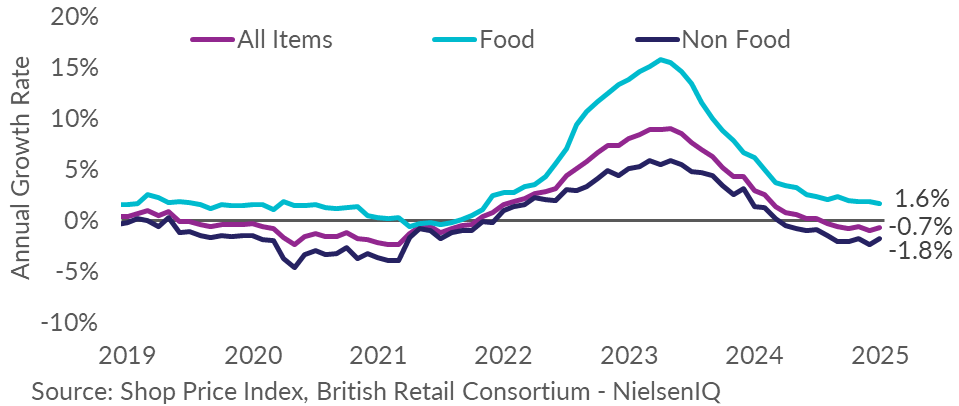Period Covered: 01 – 07
January 2025
- Shop Price deflation was 0.7% in January, above deflation of
1.0% in the previous month. This is slightly above the 3-month
average rate of -0.8%. Shop price annual growth is at its lowest
rate since August 2021.
- Non-Food remained in deflation at -1.8% in January, edging up
from -2.4% in the preceding month. This is slightly above the
3-month average rate of -2.0%. Deflation is the most since July
2021.
- Food inflation eased to 1.6% in January, down from 1.8% in
the month preceding. This is below the 3-month average rate of
1.8%. The annual rate has eased considerably since the start of
2024 and inflation remained at its lowest rate since November
2021.
- Fresh Food inflation slowed in January, at 0.9%, down from
1.2% in December 2024. This is slightly below the 3-month average
rate of 1.1%. Inflation was its lowest since October 2021.
- Ambient Food inflation edged down to 2.5% in January, from
2.8% in November. This is below the 3-month average rate of 2.7%
and remained at its lowest since February 2022.
|
|
OVERALL SPI
|
FOOD
|
NON-FOOD
|
|
% Change
|
On last year
|
On last month
|
On last year
|
On last month
|
On last year
|
On last month
|
|
Jan-25
|
-0.7
|
-0.4
|
1.6
|
0.5
|
-1.8
|
-0.9
|
|
Dec-24
|
-1.0
|
0.0
|
1.8
|
0.1
|
-2.4
|
-0.1
|
Note: Month-on-month % change refers to changes in the
level of prices.

Helen Dickinson, Chief Executive of the BRC,
said:
“While overall prices fell in January, the pace of shop price
deflation eased. Extensive January sales was good news for
bargain hunters, with non-food products showing significant
discounts, particularly for furniture and fashion, but less good
news for retailers needing to shift excess stock. This month's
figures also showed early signs of what is to come, with month on
month food prices rising at their fastest pace since April last
year. Ambient food saw a 1% jump as prices spiked for sugary
products, chocolates and alcohol.
“Price cuts and deflation may not last much longer as retailers
will soon feel the full impact of £7bn of new costs announced at
the last Budget. Higher employer NICs, increased National Living
Wage, and a new packaging levy mean that prices are expected to
rise across the board. Government can help to mitigate the impact
on consumers by ensuring its proposed reforms to business rates
do not result in any store paying more in rates than they already
do. Without action, UK households will feel the effects.”
Mike Watkins, Head of Retailer and Business Insight,
NielsenIQ, said:
“Shoppers continue to be unsure
about spending and many are seeing a continued squeeze on their
household incomes. So we expect non-food retailers to still
promote and food retailers to still offer price cuts over the
next few weeks, with shoppers managing their budgets by shopping
smart and shopping around for wherever the savings are the most
attractive.”
